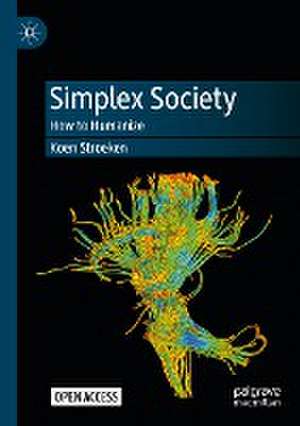Simplex Society: How to Humanize
Autor Koen Stroekenen Limba Engleză Paperback – 8 noi 2023
In Part I, a ‘speciated’ history, injected with the anthropology of Bateson and Gluckman, describes the semantic and experiential impoverishment of the lifeworld. After going through the affects of distrust (the neolithic lifeway), of futility (industrial lifeway) and disconnection (post-knowledge), the human species today depends for its survival on installing a new lifeway, which manages to wed (eco-social) inclusion to the already difficult first pair of the French Revolution. The species needs to rehumanize.
Part II illustrates the remedies currently developed: to reframe, re-sphere and re-source. What do critical street art, international football matches, presidential elections, hip-hop dissing performances, charismatic church services, intuition stimulation, and ‘pre-ceptive’ experiences of consciousness have in common? They are moments of the real. Rooted in ‘life sensing’, they are tensors organizing frameshift. As multiplex measures tackling the simplex, these tensors overcome the cultural relativism of the postmodern matrix.
| Toate formatele și edițiile | Preț | Express |
|---|---|---|
| Paperback (1) | 353.99 lei 6-8 săpt. | |
| Springer Nature Switzerland – 8 noi 2023 | 353.99 lei 6-8 săpt. | |
| Hardback (1) | 426.72 lei 6-8 săpt. | |
| Springer Nature Switzerland – 8 noi 2023 | 426.72 lei 6-8 săpt. |
Preț: 353.99 lei
Nou
Puncte Express: 531
Preț estimativ în valută:
67.74€ • 73.81$ • 57.08£
67.74€ • 73.81$ • 57.08£
Carte tipărită la comandă
Livrare economică 23 aprilie-07 mai
Preluare comenzi: 021 569.72.76
Specificații
ISBN-13: 9783031411175
ISBN-10: 303141117X
Pagini: 320
Ilustrații: X, 320 p. 28 illus.
Dimensiuni: 148 x 210 mm
Greutate: 0.4 kg
Ediția:1st ed. 2024
Editura: Springer Nature Switzerland
Colecția Palgrave Macmillan
Locul publicării:Cham, Switzerland
ISBN-10: 303141117X
Pagini: 320
Ilustrații: X, 320 p. 28 illus.
Dimensiuni: 148 x 210 mm
Greutate: 0.4 kg
Ediția:1st ed. 2024
Editura: Springer Nature Switzerland
Colecția Palgrave Macmillan
Locul publicării:Cham, Switzerland
Cuprins
Prologue.- Introduction: After Knowledge.- Part I Simplex Frames.- Chapter One: Simpl(if)ication.- Chapter Two: Frameshift.- Chapter Three: Losing the Feel for the Craft.- Chapter Four: The Human Experiment.- Chapter Five: Simplex Communication Society.- Part II Tensors of the Undertow.- Chapter Six: Collective Reason.- Chapter Seven: The Oracle and the Real.- Chapter Eight: Healer or King.- Chapter Nine: A Model Leader.- Chapter Ten: Entropology.- Chapter Eleven: Soccer as Mirror.- Chapter Twelve: Street Cred.- Chapter Thirteen: Godwork.- Chapter Fourteen: Intuition, Destiny, Love.- Chapter Fifteen: Phantoms of the Future.- Epilogue: Or 16.
Notă biografică
Koen Stroeken is an associate professor in Africanist anthropology at Ghent University, Belgium, who did his ethnographic fieldwork mostly in northern Tanzania. Stroeken co-founded CARAM, the Centre for Anthropological Research on Affect and Materiality. He authored two monographs on medico-political anthropology.
Textul de pe ultima copertă
This open access book provides thought-provoking anthropology grounded in comparative ethnography. The theory captures the current historical moment, the long-term trends that led us here, and the prospects for a humane future. The experience of complexity characterizing a globalized information society triggers simplexes. These unidimensional responses instrumental in bringing about a predictable effect are altering our ways of communicating and the technologies we design.
In Part I, a ‘speciated’ history, injected with the anthropology of Bateson and Gluckman, describes the semantic and experiential impoverishment of the lifeworld. After going through the affects of distrust (the neolithic lifeway), of futility (industrial lifeway) and disconnection (post-knowledge), the human species today depends for its survival on installing a new lifeway, which manages to wed (eco-social) inclusion to the already difficult first pair of the French Revolution. The species needs to rehumanize.
Part II illustrates the remedies currently developed: to reframe, re-sphere and re-source. What do critical street art, international football matches, presidential elections, hip-hop dissing performances, charismatic church services, intuition stimulation, and ‘pre-ceptive’ experiences of consciousness have in common? They are moments of the real. Rooted in ‘life sensing’, they are tensors organizing frameshift. As multiplex measures tackling the simplex, these tensors overcome the cultural relativism of the postmodern matrix.
In Part I, a ‘speciated’ history, injected with the anthropology of Bateson and Gluckman, describes the semantic and experiential impoverishment of the lifeworld. After going through the affects of distrust (the neolithic lifeway), of futility (industrial lifeway) and disconnection (post-knowledge), the human species today depends for its survival on installing a new lifeway, which manages to wed (eco-social) inclusion to the already difficult first pair of the French Revolution. The species needs to rehumanize.
Part II illustrates the remedies currently developed: to reframe, re-sphere and re-source. What do critical street art, international football matches, presidential elections, hip-hop dissing performances, charismatic church services, intuition stimulation, and ‘pre-ceptive’ experiences of consciousness have in common? They are moments of the real. Rooted in ‘life sensing’, they are tensors organizing frameshift. As multiplex measures tackling the simplex, these tensors overcome the cultural relativism of the postmodern matrix.
Caracteristici
Provides an original theoretical framework to examine the complexity of this era of globalization Shows the cultural dynamic of remedying a simplex with a tensor Relies on comparative ethnography, which combines interpretive ethnographic fieldwork with structuralist analysis This book is open access, which means that you have free and unlimited access
